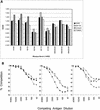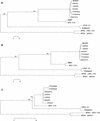Molecular evidence for distinct genotypes of monkey B virus (herpesvirus simiae) which are related to the macaque host species
- PMID: 9765470
- PMCID: PMC110342
- DOI: 10.1128/JVI.72.11.9224-9232.1998
Molecular evidence for distinct genotypes of monkey B virus (herpesvirus simiae) which are related to the macaque host species
Abstract
Although monkey B virus (herpesvirus simiae; BV) is common in all macaque species, fatal human infections appear to be associated with exposure to rhesus macaques (Macaca mulatta), suggesting that BV isolates from rhesus monkeys may be more lethal to nonmacaques than are BV strains indigenous to other macaque species. To determine if significant differences that would support this supposition exist among BV isolates, we compared multiple BV strains isolated from rhesus, cynomolgus, pigtail, and Japanese macaques. Antigenic analyses indicated that while the isolates were very closely related to one another, there are some antigenic determinants that are specific to BV isolates from different macaque species. Restriction enzyme digest patterns of viral DNA revealed marked similarities between rhesus and Japanese macaque isolates, while pigtail and cynomolgus macaque isolates had distinctive cleavage patterns. To further compare genetic diversity among BV isolates, DNA sequences from two regions of the viral genome containing genes that are conserved (UL27 and US6) and variable (US4 and US5) among primate alphaherpesviruses, as well as from two noncoding intergenic regions, were determined. From these sequence data and a phylogenetic analysis of them it was evident that while all isolates were closely related strains of BV, there were three distinct genotypes. The three BV genotypes were directly related to the macaque species of origin and were composed of (i) isolates from rhesus and Japanese macaques, (ii) cynomolgus monkey isolates, and (iii) isolates from pigtail macaques. This study demonstrates the existence of different BV genotypes which are related to the macaque host species and thus provides a molecular basis for the possible existence of BV isolates which vary in their levels of pathogenicity for nonmacaque species.
Figures






Similar articles
-
Monkey B virus (Cercopithecine herpesvirus 1).Comp Med. 2008 Feb;58(1):11-21. Comp Med. 2008. PMID: 19793452 Free PMC article. Review.
-
Detection of a unique genotype of monkey B virus (Cercopithecine herpesvirus 1) indigenous to native Japanese macaques (Macaca fuscata).Comp Med. 2002 Dec;52(6):555-9. Comp Med. 2002. PMID: 12540170
-
The existence of differing monkey B virus genotypes with possible implications for degree of virulence in humans.Lab Anim Sci. 1999 Feb;49(1):10-1. Lab Anim Sci. 1999. PMID: 10090090 No abstract available.
-
Genome sequence of a pathogenic isolate of monkey B virus (species Macacine herpesvirus 1).Arch Virol. 2014 Oct;159(10):2819-21. doi: 10.1007/s00705-014-2130-3. Epub 2014 Jun 6. Arch Virol. 2014. PMID: 24903602 Free PMC article.
-
[Pathogenesis of animal herpesviruses to human].Nihon Rinsho. 2000 Apr;58(4):957-61. Nihon Rinsho. 2000. PMID: 10774223 Review. Japanese.
Cited by
-
Macacine Herpesvirus 1 Antibody Prevalence and DNA Shedding among Invasive Rhesus Macaques, Silver Springs State Park, Florida, USA.Emerg Infect Dis. 2018 Feb;24(2):345-351. doi: 10.3201/eid2402.171439. Emerg Infect Dis. 2018. PMID: 29350146 Free PMC article.
-
Genome sequence variation among isolates of monkey B virus (Macacine alphaherpesvirus 1) from captive macaques.Virology. 2017 Aug;508:26-35. doi: 10.1016/j.virol.2017.05.001. Epub 2017 May 7. Virology. 2017. PMID: 28494342 Free PMC article.
-
Structure and sequence of the saimiriine herpesvirus 1 genome.Virology. 2011 Feb 5;410(1):181-91. doi: 10.1016/j.virol.2010.11.008. Epub 2010 Dec 3. Virology. 2011. PMID: 21130483 Free PMC article.
-
Pathogenicity of different baboon herpesvirus papio 2 isolates is characterized by either extreme neurovirulence or complete apathogenicity.J Virol. 2003 Oct;77(20):10731-9. doi: 10.1128/jvi.77.20.10731-10739.2003. J Virol. 2003. PMID: 14512523 Free PMC article.
-
Monkey B virus (Cercopithecine herpesvirus 1).Comp Med. 2008 Feb;58(1):11-21. Comp Med. 2008. PMID: 19793452 Free PMC article. Review.
References
-
- Bennett A M, Harrington L, Kelly D C. Nucleotide sequence analysis of genes encoding glycoproteins D and J in simian herpes B virus. J Gen Virol. 1992;73:2963–2967. - PubMed
-
- Benson P M, Malane S L, Banks R, Hicks C B, Hilliard J K. B virus (Herpesvirus simiae) and human infection. Arch Dermatol. 1989;125:1247–1248. - PubMed
-
- Black D, Eberle R. Detection and differentiation of primate α-herpes-viruses by PCR. J Vet Diagn Investig. 1997;9:225–231. - PubMed
-
- Centers for Disease Control. B-virus infection in humans—Pensacola, Florida. Morbid Mortal Weekly Rep. 1987;36:289–290. , 295–296. - PubMed
-
- Davenport D S, Johnson D R, Holmes G P, Jewett D A, Ross S C, Hilliard J K. Diagnosis and management of human B virus (Herpesvirus simiae) infections in Michigan. Clin Infect Dis. 1994;19:33–41. - PubMed
Publication types
MeSH terms
Substances
Grants and funding
LinkOut - more resources
Full Text Sources

